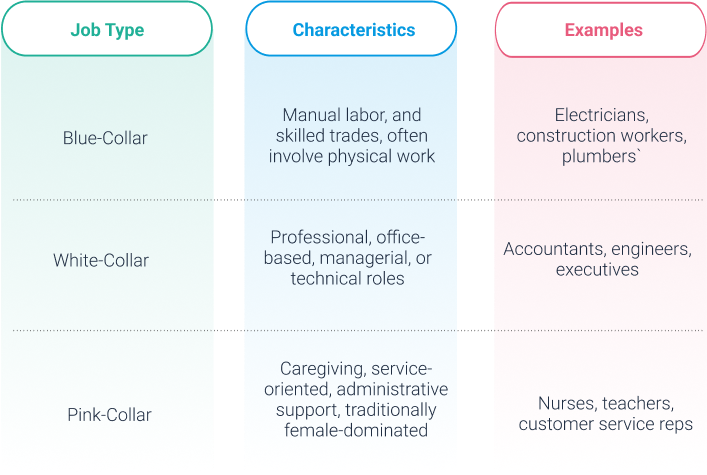The world of work has long been categorized into blue-collar and white-collar jobs, but another significant classification is pink collar jobs which has played a crucial role in shaping industries and economies. Originally associated with roles traditionally held by women, pink-collar jobs have evolved, with shifting gender norms, technological advancements, and changing workforce demands.
Understanding pink-collar jobs is essential for appreciating their economic impact, addressing workforce equity, and anticipating future employment trends. In this article, we explore what pink-collar jobs are, how they compare to other job classifications, their historical evolution, and what the future holds for workers in these fields.
What are pink-collar jobs?
The term pink-collar jobs was coined in the 1970s to describe occupations predominantly filled by women, often in caregiving, administrative, and service-oriented roles. Unlike blue-collar (manual labor) and white-collar (professional or office-based) jobs, pink-collar jobs have been traditionally associated with lower wages and limited career mobility.
Common pink-collar professions
- Healthcare: Nursing, medical assistants, home health aides
- Education: Teachers (especially in early childhood education), school counselors
- Administrative Support: Secretaries, receptionists, customer service representatives
- Service Industry: Waitresses, hairdressers, flight attendants
While these roles have been historically gender skewed, today’s workforce is seeing a shift as men enter these professions and those in these fields find their career pathways expanded.
Comparing pink-, white-, and blue-collar jobs
To better understand pink-collar jobs, it’s useful to compare them to their blue- and white-collar counterparts:

While these distinctions have historically been rigid, automation and technology are reshaping all three categories, with increasing overlaps between them in activities performed and shifting of any historic gender bias.
The evolution of pink-collar jobs
Pink-collar jobs have evolved significantly over the past century. A combination of talent market shifts, the introduction of technology, and recast societal norms have led to dramatic changes over the past half-decade.
- Mid-20th Century: Women entered the workforce in large numbers post-WWII, filling administrative and service roles.
- 1970s-1990s: Growing recognition of gender disparities in pay and career progression in pink-collar fields led to some equality advancement.
- 2000s-Present: Increased advocacy for pay equity, career growth, and gender-neutral job classifications (including job ads).
- Future Trends: Automation, AI, and policy changes driving transformations in traditionally pink-collar industries, elevating their attractiveness and importance.
Economic and social impact
Commonly seen as the backbone of the economy, particularly in healthcare, education, and customer service, they are often undervalued in terms of wages and career advancement opportunities.
Key Challenges:
- Wage disparities: Pink-collar jobs often pay less than white- or blue-collar jobs with similar skill requirements. For example, teachers with a college degree typically make more than 30% less than if they entered a different career track.
- Limited career progression: Fewer pathways to executive leadership or higher-paid roles. These jobs tend to be hierarchical, limiting career mobility and progression to only a few.
- Emotional labor demands: Pink-collar jobs require a high degree of emotional intelligence and empathy, which tend to be under-appreciated and under-compensated in comparison to the technical or physical expertise required to perform white or blue-collar jobs.
The future of pink-collar jobs
As the workforce landscape changes, traditional pink-collar professions are experiencing big transformations, changing what they do and who they employ. A few major influences include the following trends.
- Technology & AI: Automation is shifting administrative and service roles, reducing parts of what used to be manual work while also creating new opportunities.
- Gender diversity: More men are entering traditionally pink-collar fields, reducing gender-based job classifications. These new entrants are attracted to the fields thanks to expanded career mobility and enhanced societal prestige.
- Increased demand: As populations age, healthcare and education roles will continue to be in high demand. With less supply, these roles will require some augmentation in the form of new technology new workforce.
- Upskilling opportunities: Professional development programs are helping workers transition into higher-paying leadership roles within pink-collar industries. This in turn is helping these industries retain talent and attract a more diverse workforce.
Addressing bias and promoting equity
Jobs that have been historically considered “pink-collar” are an essential part of the labor market. They provide critical services that keep societies running. While historically undervalued, these roles are evolving with technology, policy changes, and shifting societal norms. Recognizing their importance, ensuring fair compensation, and providing career growth opportunities are key to building a more inclusive and balanced workforce.
The continue this evolution, employers and policymakers should add some intentionality to pink-collar job change catalysts.
- Promote fair pay by addressing wage gaps in pink-collar professions. Pay transparency regulations have been helpful, but may not be enough by themselves.
- Craft inclusive job ads that welcome a wider variety of talent to consider the role. To make this second nature consider an AI-powered smart editor. Elevate all your jobs and writers in a brand-consistent manner.
- Offer career development programs that provide upward mobility.
- Challenge gender stereotypes to ensure equitable access to all job types, just ensure it goes beyond merely eliminating gendered language
- Leverage technology responsibly to enhance, rather than replace, human-centric roles. Thoughtful adoption of AI and analytics-powered Insights can be game-changers for your ability to attract and retain qualified talent.
As we move toward a more dynamic workforce, embracing and redefining pink-collar jobs will be crucial in shaping a fairer and more inclusive economy. Let’s recognize the value of these roles. Let’s work towards a future where all jobs, regardless of classification, are respected and rewarded fairly. Want help doing this today, our talent attraction experts can help!
